�
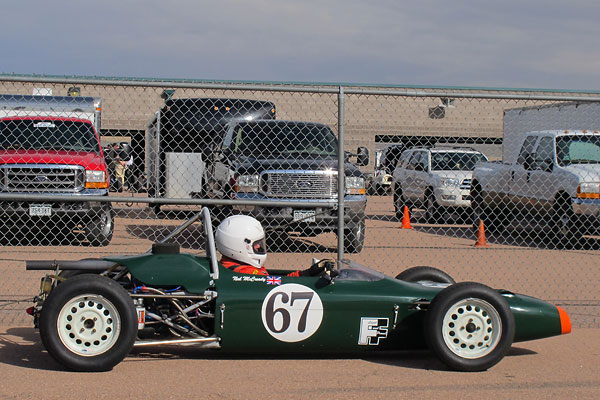
�
�
Neil McCready's Merlyn Mk20 Formula Ford Race Car
� � Owner: Neil McCready� City: Denver, Colorado
� Chassis: Merlyn Mk20 (circa 1971)
� Engine: 1.6L Ford four-cylinder
� Race prepared by: owner�
�
The Merlyn Mk20 Model
��
Colchester Racing Developments' highly successful 11A model was produced from 1968 through 1969.�
For 1970, the company's design was slightly improved and was assigned a new type designation: "17".�
The most significant feature change was a separately detachable nose cone which facilitated easier�
service and transportation but didn't make the cars any quicker. For 1971, far more significant�
changes were made. The new type "20" featured larger diameter lower longitudinal frame tubes and�
new X-shaped bracing over the driver's knees in lieu of a single diagonal brace. These two changes�
were evidently intended to improve chassis stiffness but they enhanced crashworthiness too.�
Lower control arm mounting points on the frame were entirely relocated and redesigned to achieve�
an anti-dive characteristic under braking. The standard location of the engine oil reservoir was�
relocated from the nose of the car to just behind the firewall. A new exhaust header routed up and�
over the rear bulkhead instead of threading through the rear suspension. In combination, these�
changes represented meaningful improvements to an already well-proven and winning design.�
�
The Merlyn Mk20 was further developed during the 1971 season. Works driver Jody Scheckter raced�
Merlyns in both Formula Ford and Formula Three. At that time, the differences between the two�
classifications were small. Arguably, the most important difference was that Formula Fords raced�
on street tires whereas Formula Three cars rolled on specialized racing tires; to get optimal�
performance from the latter, CRD shifted rear suspension mounting points slightly. (Engines on�
Formula Three cars were very much more highly tuned, but their output was largely hampered by�
restrictor plates.)�
�
A special short nosecone, developed for Jody Scheckter during the course of the 1971 season,�
was the most readily identifiable feature of 1972's "Mk20A" model. Various chassis and component�
changes were made as well, but are outside the scope of this article. The famous Jim Russell driving�
school was the major customer for Merlyn Mk20A racecars, and ex-school cars are typically found�
with type number "20AS" stamped into their chassis plates. �
�
�
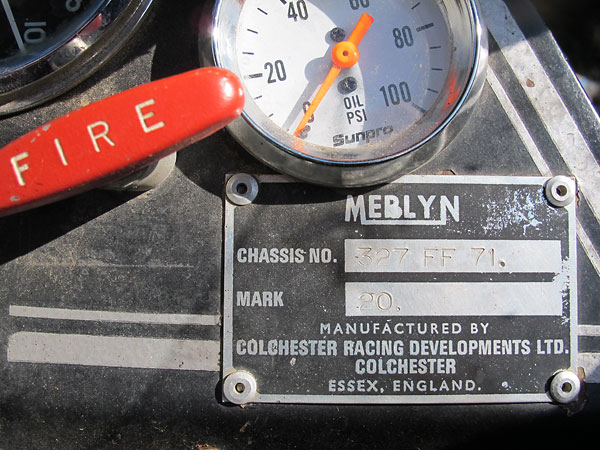
�
MERLYN - Chassis No. 327 FF 71. - Mark 20.
�
Manufactured by Colchester Racing Developments Ltd. - Colchester - Essex, England.
�
�
IMPORTANT ANNOUNCEMENT
�
BritishRaceCar.com will have to cut back plans for continued growth if we can't find more financial support.
�
If you like what you've found here, and you want to see more, please click here and follow the instructions.
�
Readers like you keep BritishRaceCar.com online and growing through voluntary financial contributions.
�
�

�
Colchester Racing Developments' frame serial number: "Mk20 29"
�
 �
�
�
�
Features and Specifications (as currently presented)
�| Engine: | �1.6L Ford four-cylinder engine (with 711M6015BA engine block. 9.3:1 compression ratio).�
Scholar cylinder head.�
Weber 32/36 DGV carburetor.�
Ramair model FF65 air filter.�
Motorcraft distributor.�
Pertronix Ignitor breakerless ignition module.�
Taylor Spiro Pro 8mm spark plug wires.�
Dry sump lubrication system.�
Titan oil pump.�
K&N HP-300L oil filter. | �
| Cooling: | �copper and brass crossflow radiator.�
Earl's 10-row oil cooler. | �
| Exhaust: | �custom 4-into-1 header. | �
| Transaxle: | �Hewland Mk8 4-speed.�
Open differential.�
Metalastic drive donuts.�
Donut Savers. | �
| Front Susp.: | �unequal length wide-based wishbones.�
Triumph Herald (Alford & Alder, forged) uprights.�
SPAX single-adjustable coilover shock absorbers.�
Hyperco springs.�
Adjustable anti-sway bar. | �
| Rear Susp.: | �inverted lower wishbones, single top links, and twin adjustable trailing links.�
Proprietary Merlyn magnesium uprights.�
SPAX single-adjustable coilover shock absorbers.�
Hyperco springs.�
Adjustable anti-sway bar. | �
| Brakes: | �(master) dual Girling master cylinders. Adjustable bias bar. Safety Brakers (front & rear). � (front) Girling 14LF calipers. Triumph Spitfire MkIV rotors. � (rear) Girling 12SP calipers. Triumph Spitfire MkIV rotors. | �
| Wheels/Tires: | �Weber Racing steel disc wheels.�
Dunlop Racing Formula Ford tires (135/545-13 front and 165/580-13 rear, CR82 tread compound). | �
| Electrical: | �Lucas starter. Lead/acid battery. | �
| Instruments: | �(left to right)�
Stewart Warner water temperature gauge (100-250F),�
Smiths Chronometric tachometer with tattle-tale (0-8000rpm),�
Sunpro oil pressure gauge (0-100psi). | �
| Fuel System: | �ATL under seat fuel cell.�
FF1600 fuel pump with push-on fittings. | �
| Safety Eqmt: | �Crow Enterprises safety harness.�
FireBottle fire suppression system. | �
| Racing Class: | �Formula Ford | �
Engine Installation
��

�
Cylinder head porting is critically important in the Formula Ford racing class, because very
�
specific rules limit other modifications from stock. Historically, Scholar and Minister were
�
Britain's two leading purveyors of cylinder heads: Neil's head is vintage Scholar. Underneath?
�
Neil rebuilt his own Formula Ford engine. He reports that the whole job cost less than $3K.
�
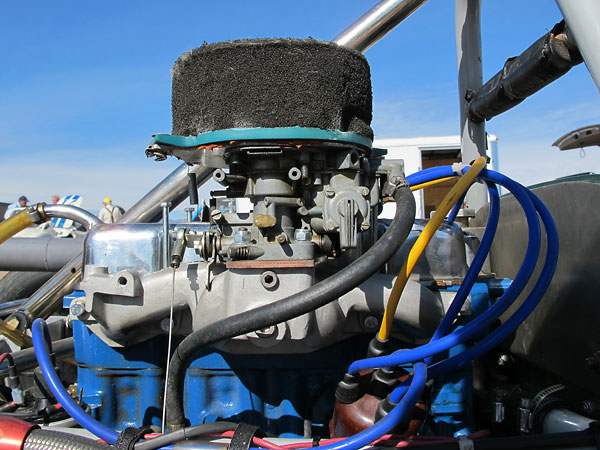
�
Weber 32/36 DGV carburetor. Ramair model FF65 air filter.
�
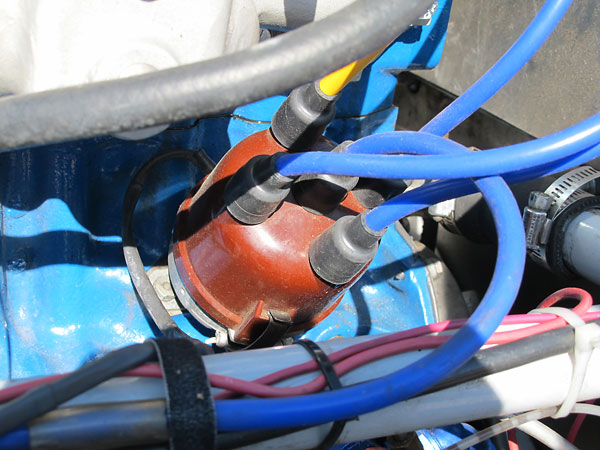
�
Motorcraft distributor (with Pertronix Ignitor module inside) and Taylor Spiro Pro 8mm spark plug wires.
�
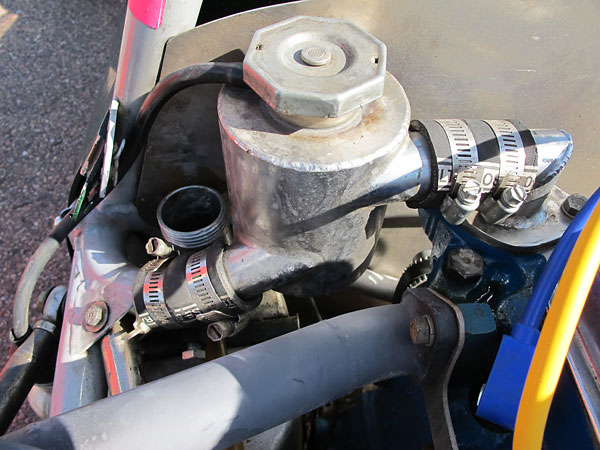
�
Aluminum header tank / swirl pot. Coolant routes to the nose-mounted radiator through frame tubes.
�
(Open filler at left is for the engine oil tank, which Neil was topping off as we were taking photos.)
�
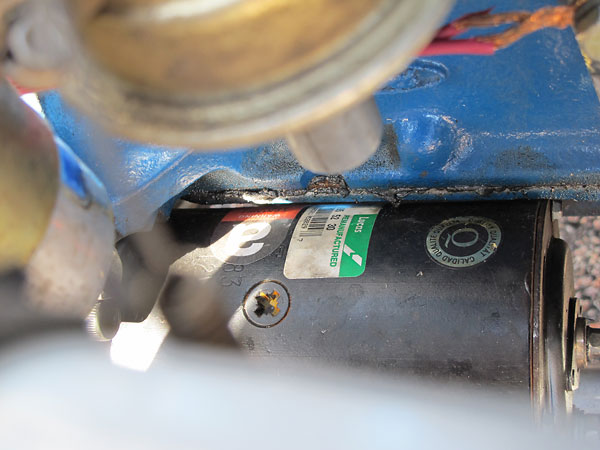
�
Lucas starter motor.
�
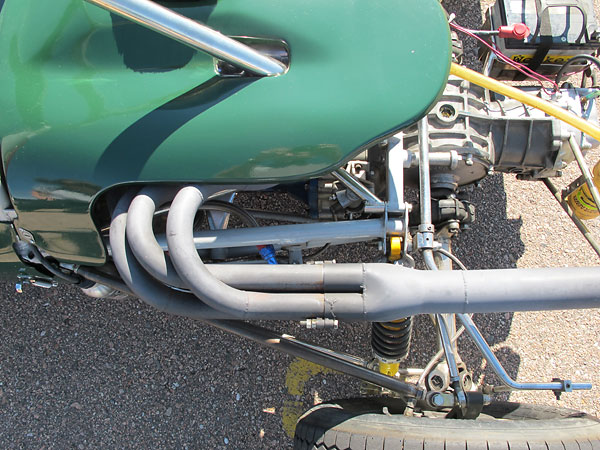
�
The most service-friendly color for header paint is black. Why? If a leak develops, it shows up white.
�
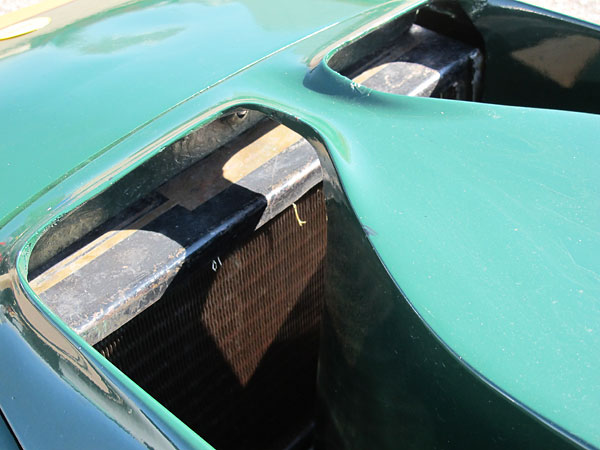
�
Copper and brass crossflow radiator. On the Merlyn 11 and 11A models, radiator airflow had been
�
vented to the sides. Starting with the Merlyn 17, airflow was vented upward as shown here.
�
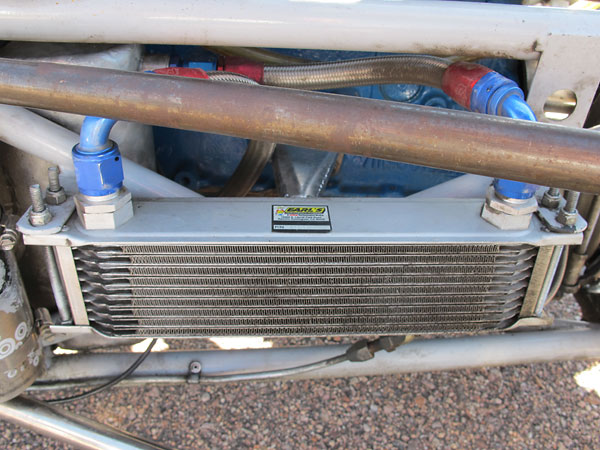
�
Earl's 10-row oil cooler. More interestingly, behind it you can see the engine oil reservoir.
�
On previous Merlyn models, oil reservoirs were mounted ahead of the front bulkhead. The rearward
�
location is better in terms of weight and weight distribution, plus plumbing is simpler.
�
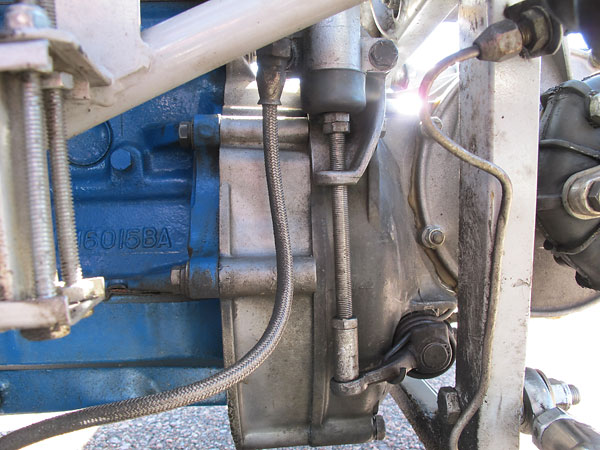
�
Bellhousing, clutch linkage, and Girling clutch slave cylinder.
�

�
Hewland Engineering Limited, Maidenhead. Serial number: H8-716.
�
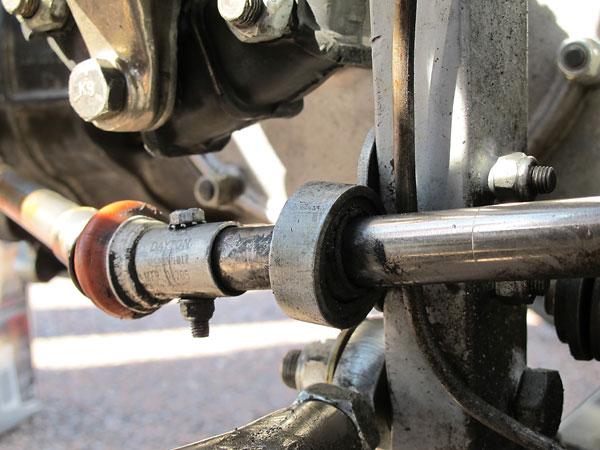
�
A spherical bearing locates the shifter linkage. A sealed Apex-Dayton u-joint is a significant upgrade.
�
Please support the sponsoring companies who make www.BritishRaceCar.com possible, including:
� �
 �
�
�
�
Front Suspension
��
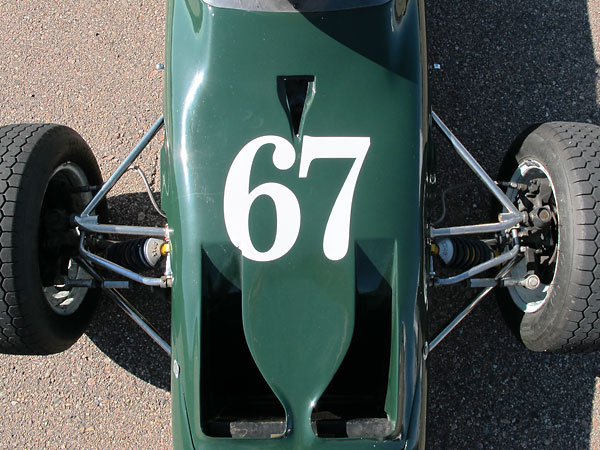
�
The dramatically updated anti-dive front suspension of the Merlyn Mk20 Formula Ford (circa 1971.)
�
Merlyn drivers placed 1st, 2nd, and 3rd place in both the 1970 and 1971 British championships.
�

�
As a general rule, racetracks are smoother today than they were back in the day. Tires are
�
different too. For those reasons, Formula Fords usually run on stiffer than original springs.
�
(This car: 220#/inch front and about 180#/inch rear.)
�

�
In side view with the wheel removed you would see that the A-arm mounting points on the chassis
�
converge to the rear. So configured, the torque reaction of braking partially cancels the
�
natural tendency of the front suspension to plunge downward.
�
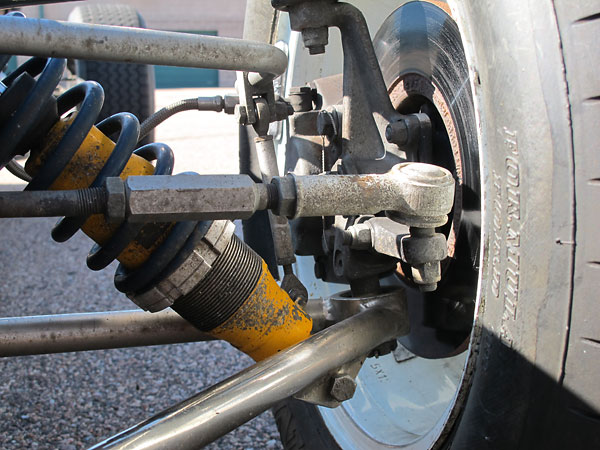
�
Triumph Herald (Alford & Alder) forged uprights.
�

�
SPAX single-adjustable coilover shock absorbers. Hyperco springs.
�
�
Enjoying this article? www.BritishRaceCar.com is partially funded through generous support from readers like you!
�
To contribute to our operating budget, please click here and follow the instructions.
�
(Suggested contribution is twenty bucks per year. Feel free to give more!)�
Rear Suspension
��
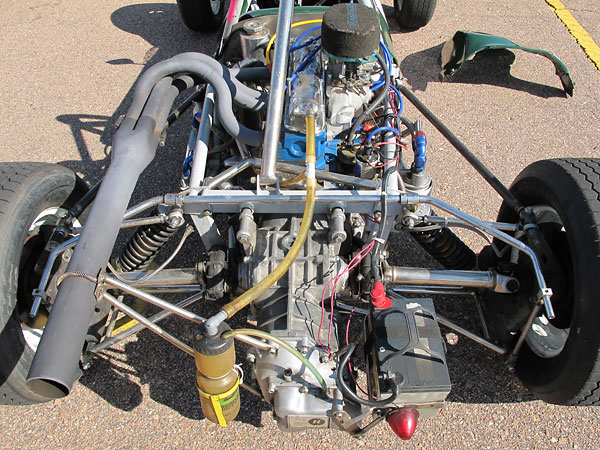
�
Inverted lower wishbones, single top links, and twin adjustable trailing links.
�
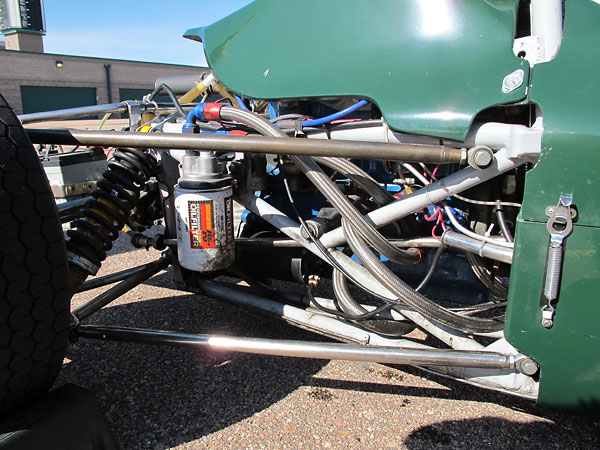
�
The upper trailing links have recently been replaced. The new parts haven't yet been nickel plated.
�
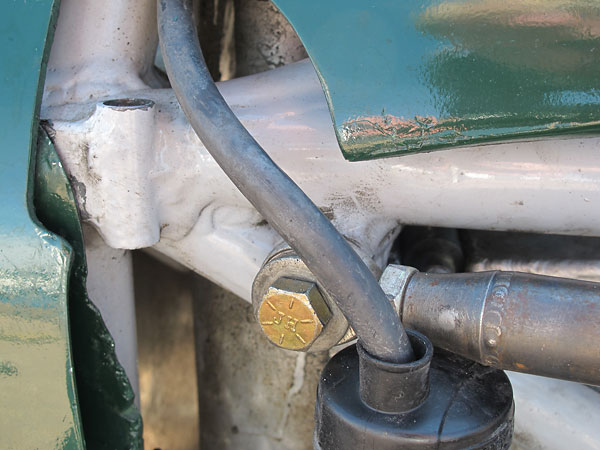
�
A similar frame was used for Merlyn's Formula Three cars. Alternate trailing link attachment points
�
were evidently used in conjunction with Formula Three spec racing slicks.
�
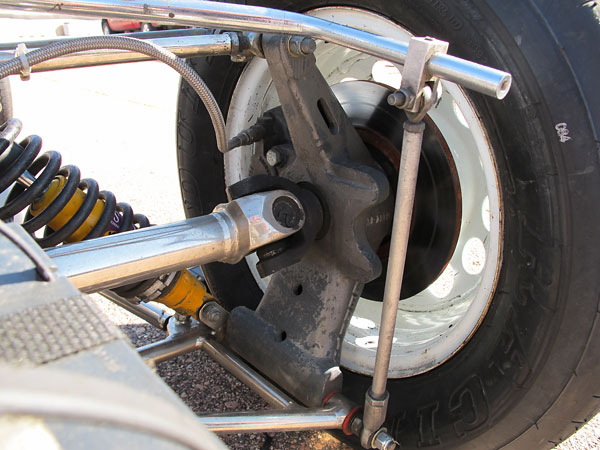
�
Triumph Spitfire brake rotors are used both front and rear, so replacements are readily available.
�
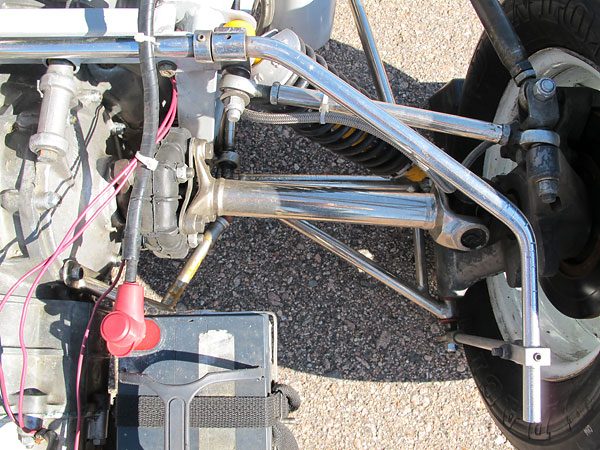
�
Metalastic drive donuts. Donut Savers. Battery size and location is probably original.
�
(For 2012 an Odyssey AGM dry cell battery has been installed, mounted under the driver's knees.)
�

�
The right rear upright is original but the left one has been replaced recently. The replacement
�
part is aluminum instead of magnesium. Aluminum is significantly stronger, less susceptible
�
to corrosion, and only about half a pound heavier. Cost? About $650 each.
�
�
Interior
��

�
The original Merlyn fiberglass seat is in good condition, but Neil plans to set it aside next
�
season in favor of one that will suit his physique better. Crow Enterprises safety harness.
�
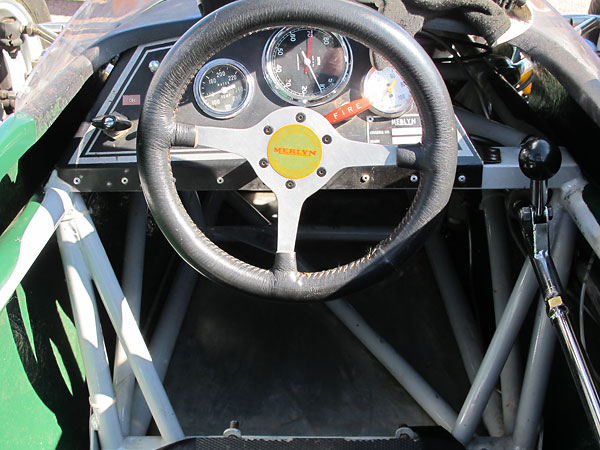
�
Neil has the car's original Smiths gauges, but keeps them in safe storage. Here: Stewart Warner
�
water temp gauge, a Smiths Chronometric tach with tattle-tale, and a Sunpro oil pressure gauge.
�
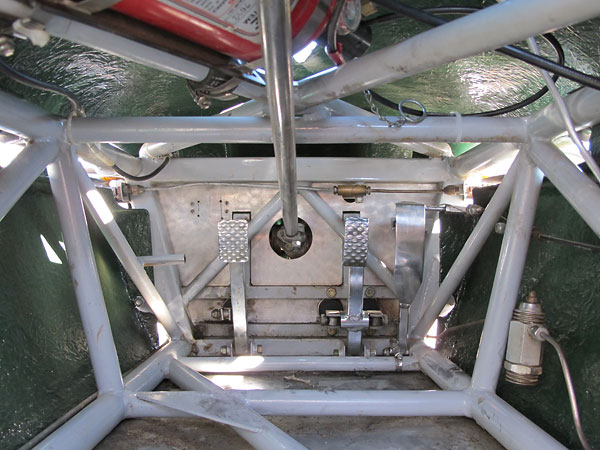
�
Neil has done a lot of work on the pedals to make room for wide feet. It wasn't necessary to shift
�
the master cylinders, but he did shift the throttle pedal over and relocated the throttle cable to the
�
outside of the frame. The width of the brake pedal and dead pedal have been reduced about 1" each.
�
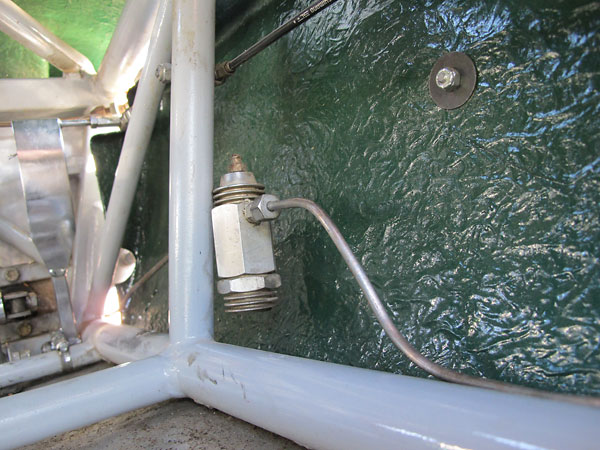
�
Period accessory: colorful and well-known racer Bob Booth of California used to produce and market
�
Safety Brakers as an anti-skid device. Taken apart, they're just a piston working against a stiff spring.
�
By leveling pressure spikes, they can in fact help to reduce locking of an inside wheel but the benefit
�
is modest and it comes with a slight increase in pedal travel. Neil tells us that his brake pedal
�
is hard and the Safety Brakers aren't leaking, so he hasn't been motivated to remove them.
�
He explained: "I'm a big believer in only changing what's necessary."
�
�
Exterior
� �
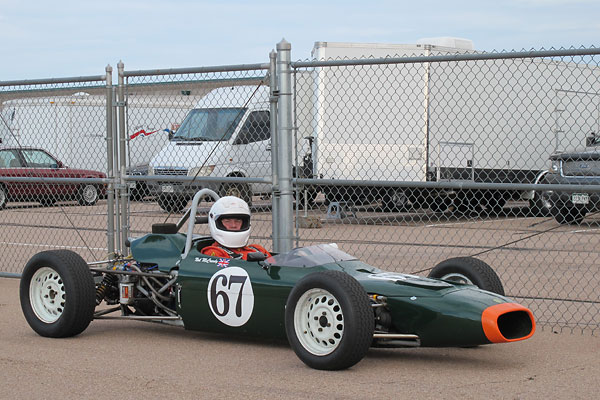
�
We enjoyed watching Neil race his Merlyn Mk20 at Pikes Peak International Raceway near Colorado
�
Springs during the Rocky Mountain Vintage Racers' Octoberfast/Spooktacular 2011 event. In Saturday
�
afternoon's feature race, Neil lapped the 1.400 mile circuit at 1:05.824 for an average speed of 76.6mph.
�
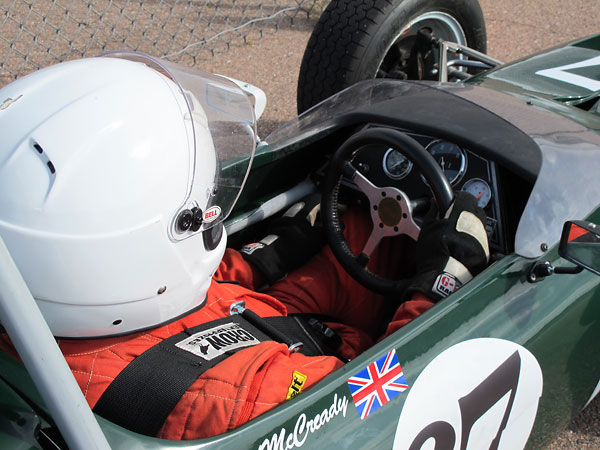
�
British expatriate Neil McCready, strapped in and ready to race.
�
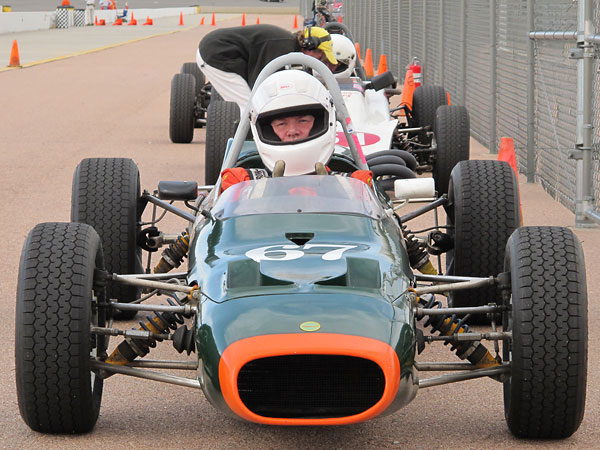
�
Seeking a new challenge after winning a whole lot of races in his MGB sports car, Neil went looking
�
for a Formula Ford. His purchase decision came down to two cars: a�
Royale RP3-A and this Merlyn
�
Mk20. For Neil, the deciding factor was that Colchester Racing Developments is still in business,
�
so top quality spare parts are more readily available and affordable for the Merlyn.
�
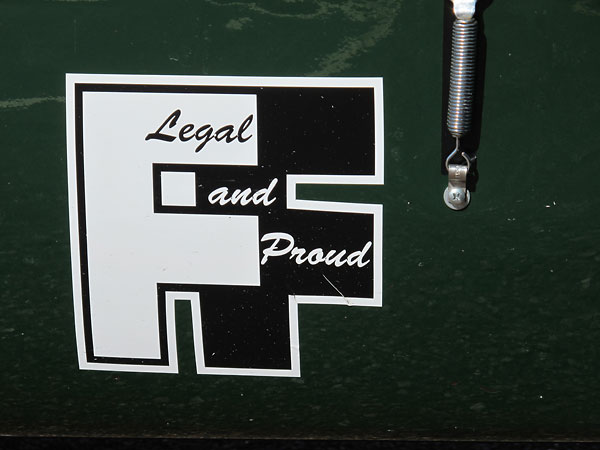
�
Rocky Mountain Vintage Racers created their "Formula Ford / Legal and Proud" program in 1996.
�
It proscribed a methodology by which approved inspectors could ascertain and certify compliance of
�
the cars to long-standing SCCA rules. Simple and standardized measurements are the core of the
�
inspection process. The program has restored Formula Ford as a home of particularly close racing.
�
Incidentally, RMVR welcomes Formula Fords built from 1973 through 1981 (a.k.a. "Club Fords").
�
�
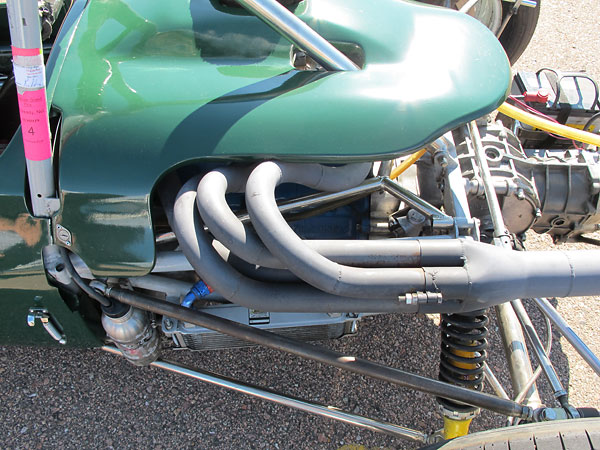
�
Formula Fords may race with either of two engine specifications: "Cortina" or "Uprated" (a.k.a. "Kent").
�
Early North American Formula Fords originally used Cortina engines, but most have since been updated
�
to newer Kent specifications. Two different cylinder heads. The Cortina version had combustion chambers
�
cast into the head and flat-top pistons whereas the Kent engines had flat cylinder heads in combination
�
with shaped pistons. Kent engines typically produces more power due to bigger valves and they're more
�
robust due to better main bearing caps. Intake manifolds and carburetors are different too.
�
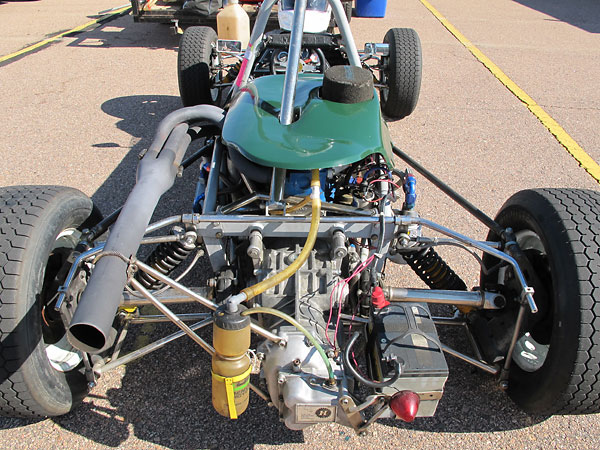
�
Neil is only just getting to know this newly acquired racecar; he hasn't yet had occasion to open up its
�
gearbox to see what gears are inside. At Pikes Peak International Raceway he gave us this observation:
�
"The gearing is a little long-legged here, perfect at High Plains Raceway, and weird at Pueblo."
�

�
Fiberglass engine cover.
�

�
Weber Racing steel wheels.
�
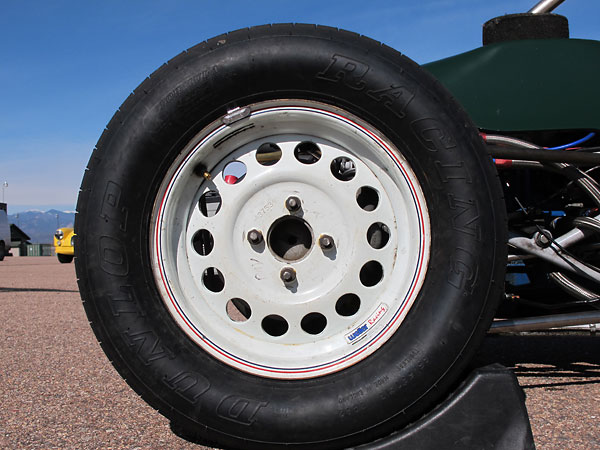
�
Dunlop Racing tires (135/545-13 front, 165/580-13 rear, CR82 tread).
�
�
�
Unless otherwise noted, all photos shown here are from October 2011 when we viewed the car at�
The Rocky Mountain Vintage Racers' "Spooktacular" at Pikes Peak International Raceway near Colorado Springs, Colorado.�
All photos by Curtis Jacobson for BritishRaceCar.com,�
copyright 2012. All rights reserved.
�
| If you liked this article, you'll probably also enjoy these: | �|||||
 | �
Bernard Bradpiece '69 Merlyn 11A | �
 | �
Scott Fairchild '72 Royale RP3A | �
 | �
Andy Antipas '73 Titan Mk6 | �
| You're invited to discuss anything you've seen here on The British Racecar Motorsports Forum! | �|||||
�
Notice: all the articles and almost all the photos on BritishRacecar.com are by Curtis Jacobson.
�
(Photos that aren't by Curtis are explicitly credited.) Reproduction without prior written permission is prohibited.
�
Contact us to purchase images or reproduction permission. Higher resolution images are optionally available.
�

 �
�